 “Hey! Aren’t you the guy that does that history commercial every night on TV?”
“Hey! Aren’t you the guy that does that history commercial every night on TV?”
I was walking back to my office one afternoon after lunch in Chatham Square here in Savannah, and that question was shouted at me from a guy unloading a truck on Gaston Street. That history commercial? He was referring to Today in Georgia History. I was flattered that he watched the show and, as we say, tickled at his notion of what the 90-second program was. Yep, that’s me, I said. “Keep it up, it’s great!” he shouted back.
The Georgia Historical Society launched Today in Georgia History, a daily 90-second TV and radio program, on Georgia Public Broadcasting in September 2011, and it has been a rewarding and powerful way for GHS to fulfill its mission, to reach new audiences, and to teach Georgia history on a daily basis. The program was produced in collaboration with GPB. In addition to receiving the praise of viewers, this innovative program has won two Emmy Awards, a Leadership in History Award from the American Association of State and Local History, and a Georgia Historical Records Advisory Board Award for Excellence in the Educational Use of Historical Records.
Today in Georgia History, or TIGH as we call it, features historical events or people associated with a particular day in Georgia history. TIGH began with the question, how can the Georgia Historical Society teach Georgia history every day in a way that will be entertaining and educational, help raise our visibility around the state, and get audiences to stand on new ground and see the past in a different way?
 We proposed the idea of a short 1-2 minute daily radio program to Teya Ryan, President and Executive Director of Georgia Public Broadcasting, and she loved it. But, she asked, why limit it to radio? She saw the potential for something much bigger—radio yes, but let’s broadcast it on TV and internet as well, with illustrations, photographs, maps, and other graphics that flesh out each subject in a more meaningful way, and broadcast it across the state—and into Georgia classrooms—every day.
We proposed the idea of a short 1-2 minute daily radio program to Teya Ryan, President and Executive Director of Georgia Public Broadcasting, and she loved it. But, she asked, why limit it to radio? She saw the potential for something much bigger—radio yes, but let’s broadcast it on TV and internet as well, with illustrations, photographs, maps, and other graphics that flesh out each subject in a more meaningful way, and broadcast it across the state—and into Georgia classrooms—every day.
This turned out to be a good decision for many reasons. The ability to market TIGH as an educational program is tied very directly to the visual product; teachers made it clear to us that the program would be more useful in the classroom if there was a visual element rather than just an audio segment. And ultimately, as regards funding, the ability to reach students and teachers is vital to the success of any project like this, because it’s been our experience that getting funding for education projects for children is easier than for other types of programs, like lectures for adults.
Both Teya and my boss, Todd Groce, GHS President and CEO, wanted me to act not only as lead researcher and writer of each episode, but also as the face and voice of the show as well. Why me? We wanted the show to be more than just the usual trivia that often makes up the “today in history” spots in the media, and in addition to my background with both journalism and history degrees, they felt that having an honest-to-goodness professionally trained historian as the on-air host—rather than just hiring an actor to read a teleprompter—would give the show a credibility and authenticity it might not otherwise have. “You’ll be the Steve Thomas of Today in Georgia History!” Teya told me, and as a fan of both the show and the long-time host of This Old House, I was excited and grateful for the opportunity.
So we began work on creating a daily TV show that would tell Georgia’s story in a new and hopefully thought-provoking way—and do it in less than 90 seconds and about 165 words. At one point we counted over a hundred people at both GHS and GPB working on the show. Georgia Public Broadcasting put together a team of seasoned and dedicated professionals that included producers, editors, sound and lighting technicians, graphic artists, and set designers.

It was my great pleasure—and it was great fun—to work with legendary Atlanta producers Don Smith and Bruce Burckhardt, and the GPB crew that included Keocia Howard, Mark Harmon, Ashlie Wilson, Rosser Shymanski, Layron Branham, Marilyn Stansbury, Bob Brienza, Tom Spencer, Tiffany Brown Rideaux, and all the other talented folks at GPB who worked so hard to make me sound and look good. GPB commissioned an original score for the TIGH theme music that TV viewers and radio listeners would instantly recognize as belonging to our show.
The GPB team worked with a dedicated group of staff and interns at the Georgia Historical Society, including my colleagues Laura García-Culler (who acted as GHS’s executive producer), Christy Crisp, Leanda Rix, Katharine Rapkin, Maggie Brewer, Sophia Sineath, Elise Lapaglia, and Alison Zielenbach. They worked tirelessly to track down the images from hundreds of institutions across the country that would flesh out and illustrate that day’s subject. Not only did using these illustrations help promote the GHS collections and those of other repositories but also demonstrated the ongoing need for institutions like ours that preserve the documentary evidence of the past.
We didn’t shy away from controversial topics either; we took an unflinching look, for example, at the myriad ways in which slavery, Jim Crow, and the continuing problems of race have shaped Georgia’s history and identity right up to the present. The production team put into daily practice on TIGH what we at GHS do as an institution every day: GHS as a public history institution serves as a bridge between the academy and the public, taking the best of cutting-edge historical scholarship and making it accessible to the lay public without watering it down. This was one of the reasons the show received so many accolades from viewers and professionals alike.
The project began in the spring of 2011 and by the time production ended a year later, we had collaboratively created an impressive body of work that over the course of 366 days (leap year!) covers the entire scope and sweep of Georgia history, from 1526 to 2009. We told the stories of artists, authors, athletes, singers, actors, poets, musicians, architects, politicians, civil rights leaders, agriculture, aviation, military history, Native American history, political history, economic and business leaders, sports, education, weather history, cultural topics and religious subjects, covering every historical era from the colonial period through the 21st century. There’s no facet of Georgia history that we didn’t cover in the course of the year.
In order to help fund the project as part of a larger capacity building campaign, GHS secured a $900,000 grant from the Robert W. Woodruff Foundation. We needed to raise our visibility across the state, particularly in Atlanta, to help the institution attract the resources it would need to sustain future growth. When we invited someone to become a GHS member or walked into a corporate or foundation office, we wanted them to know who we were, and TIGH has helped raise the visibility of our brand in every corner of the state.
In addition to daily radio and television broadcasts, we created an interactive website, www.todayingeorgiahistory.org, to serve as an educational resource for teachers and students. Many history classes around the state begin their day by watching the daily segments on the internet. The site features audio and video streaming of each segment, as well as transcripts, tips for teachers, curriculum, writing prompts, review questions, discussion topics, classroom exercises, follow-up research topics, and selected primary source materials. The web resources align with Georgia’s social studies curriculum and performance standards.
Public response to TIGH has been overwhelming and positive. No other kind of program we’ve done has matched this one in reach. By the end of 2012 nearly six million Georgians had seen or heard the program and it was being used by thousands of Georgia teachers and students in the classroom. And it will continue to live for years to come on the internet.
For me, working on “that history commercial” was one of the most professionally rewarding things I’ve ever done. When the show won two Emmys—for short-form writing and overall cultural and historical excellence—at the regional National Academy of Television Arts & Sciences gala in Atlanta on June 8, 2013, it was a tribute to the hard work and dedication of all the talented professionals at both organizations who worked on the show. I will always be proud to have been part of the TIGH team.


